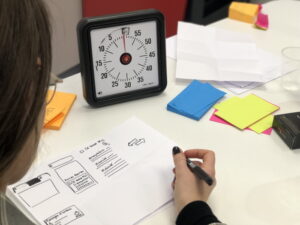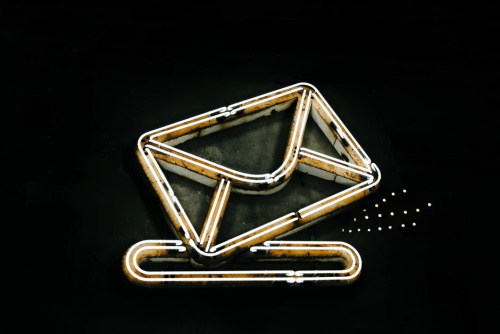I stared at boxes of printed newsletters and questioned my commitment to printed newsletters. Was this worth the expense? Should I send an email newsletter instead? And if so, how often?
I’ll share with you why I switched from a printed to a digital newsletter and how often you should send an email newsletter.
Newsletters and blogs are essential forms of communication with your clients. Businesses operate with the assumption that those who buy from you or contract your services are busy people. Many organizations and priorities are competing for people’s attention.
In addition to the challenge of digital competition, life abounds with distractions. With the constant news of crises, you have to make more effort than ever before to remind people of your existence. At the same time, you need to do so in a way that’s neither intrusive nor annoying.
Opt-in newsletters and blogs present an elegant and—if you produce them well—engaging way to capture and retain your readers’ interests.
Let me share my perspective on the difference between email newsletters and blogs
To be relevant, you need to post on your blog one to seven times a week. Whatever frequency you choose, be as consistent as possible.
Personally, I would think twice before committing to a daily blog. A team of writers would make this easy. Most solo entrepreneurs would find it a huge commitment.
Blog posts traditionally run 500 to 800 words in length. Google prefers also that you occasionally write even longer blog posts. Overall, they will provide bite-sized chunks of information.
On the other hand, newsletters are typically less frequent than blog publication and can be lengthier. How you send your newsletter is a crucial factor in how often you send It.
Let me explain. When I ran my legal nurse consulting company, I created quarterly newsletters – at first. I wrote the content, got them laid out, printed and mailed. Yes, they were printed.
Here were the challenges with printed newsletters
First, I had to decide how much information to include and on what topics. I served attorneys who handled cases with medical issues. Not all of my clients handled the same kinds of cases. The medical malpractice attorneys had specific interests that were different than attorneys who handled car crashes or slips and falls. I picked topics that were more general, like how to analyze medical records.
My first newsletters filled four pages of an 11 x 17-inch paper, which was folded and designed as a self-mailer. How much did I have to write to fill four pages? A lot. The newsletter typically had 3 or 4 articles.
When I first started sending newsletters, I had a small mailing list. As my list grew, my printing costs also grew. I priced different printers to see what thousands of copies would cost. Answer: thousands of dollars.
I had to have a person on staff who had the skills to lay out the newsletter. That took time to achieve. I paid for postage.
After sending out a quarterly 4-page newsletter for several years, I got feedback that I should consider preparing a shorter newsletter. I decided to cut back to a newsletter that was front and back. That meant I had to get it folded in thirds and closed somehow.
I bought a folding machine. It was a heavy noisy beast that occupied the table in my library, and it required constant care to avoid jamming.
Then we tackled how to keep a folded newsletter closed. We tried staples for closing the newsletter. Staples are not a good choice for mailing machines. Labels were a better choice, but someone had to apply them by hand. We bought little circles that we folded in half to close the paper.
Next, I decided to bypass folding and closing newsletters. What if I kept them flat? What if I added a cover letter?
Great plan, we thought! We can create peel-off clear or white labels printed with the person’s name and address and put them on large flat envelopes containing the newsletter and cover letter.
There is an art in getting the names and addresses to appear on the right part of the label. And there is an art in peeling labels off the laser printer roller without damaging the roller, burning yourself, or electrocuting yourself.
I reasoned if I used a large flat envelope that would include the letter and newsletter, I could save on the step of printing mailing labels. And it would not have to be folded. I ordered envelopes with our logo and return address and a window so that the address on the letter would be visible.
We experimented with how to lay out the letter so that the address would be visible and found just the right spot.
I took the project to a center that employed mentally handicapped people to give them the revenue for stuffing the envelopes. When the post office began returning undeliverable envelopes to me, I saw that some of the workers put the letter in backward, hiding the address.
When I called the supervisor of the workers, he asked me on my next batch to staple the newsletter and cover letter together and indicate which was the front.
There was no next batch. My desire to help the handicapped ended.
I assigned stuffing envelopes to one of my support staff, who loved the work because she could do it at home and it fattened her paycheck.
These experiences with printed newsletters led to me to move to a digital newsletter. No designing, no printing, no envelope stuffing, no postage. And I could send it out as often as I wished.
I went from spending several thousand dollars on printed newsletters to spending only the time of my support staff to send an email newsletter. Sending digital newsletters meant I could segment my email list so that I sent information tailored to the needs of my clients. For example, I mailed content about medical malpractice to attorneys who handled those cases and different information to personal injury attorneys who were more interested in car crashes.

How often should you go through the effort of creating an email newsletter?
Your newsletter may be published once a week or once a month. Although there are people who send daily newsletters, you run the risk of annoying your subscribers.
Again, be consistent. Also, see what frequency works best. You can often determine this by checking the unsubscribe rate immediately after you’ve sent out a newsletter. A high rate may reflect a “Oh, no, not again” reaction.
A newsletter provides information in a more leisurely way. Here, you can offer a more extensive look at industry or consumer issues. You can interview an influencer or publish guest articles. Share in-depth looks at new services you’re developing. You can profile an employee who has made significant contributions to your business.
With our shortened attention spans, I recommend shorter newsletters. One article and a link to a video or podcast should be enough. If you request any of our free reports on patiyer.com, you’ll receive our once-a-week ezines, and will quickly notice how I keep content relevant and brief.
Both your newsletters and your blogs should always provide links to your website. Explore the opportunities to publish newsletters on LinkedIn.
How Can You Drive Readers to Both Forms of Publication?
Newsletters and blog posts can be interactive. Strive for engagement with blog posts or a longer article when you send an email newsletter. A newsletter can highlight recent blog posts. For example, you can add links to your most viewed blog posts and encourage the reader to click a link or button to read the full post.
Another way to generate client interest is to invite comments. Make this invitation in a way that shows you genuinely care about the readers’ opinions. Reinforce this by answering those who respond and (with permission) quoting responses.
With care and commitment, you can turn your newsletter and blog into a voice that authentically represents your appreciation of the people who make your business thrive.
And I know that physical snail mail is a novelty these days, and some marketers recommend sending out printed newsletters. I’m not returning to that practice any time soon.
See my ezine system in action by requesting our free reports on patiyer.com and you’ll receive our weekly ezine. You can model your digital newsletter after mine.
